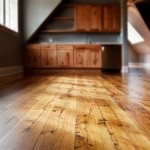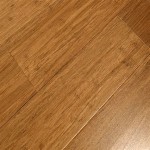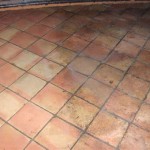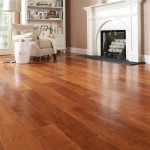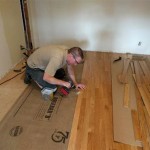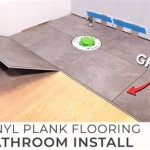Can Vinyl Plank Flooring Be Installed Over Plywood?
Vinyl plank flooring has surged in popularity as a cost-effective, durable, and aesthetically pleasing alternative to traditional flooring options like hardwood, tile, and laminate. Its water resistance, ease of installation, and wide variety of styles make it a compelling choice for homeowners and contractors alike. A common question that arises during the planning stages of a flooring project is whether vinyl plank flooring can be installed directly over a plywood subfloor. The answer, while generally yes, is nuanced and depends on several crucial factors.
Plywood is a widely used subfloor material in residential and commercial construction. Its strength and stability provide a solid base for various flooring coverings. However, simply laying vinyl plank directly onto plywood without proper preparation can lead to problems down the line, affecting the longevity, appearance, and performance of the finished floor. Understanding the conditions that must be met and the necessary steps to take are essential for a successful and long-lasting installation.
The compatibility of vinyl plank flooring with plywood revolves around the condition of the plywood itself, the type of vinyl plank being used, and adherence to manufacturer's recommendations. Ignoring these considerations can result in issues such as uneven surfaces, telegraphing of imperfections, adhesive failure, and premature wear and tear of the vinyl plank.
Ensuring the Plywood Subfloor Is Suitable
The primary determinant of whether vinyl plank can be successfully installed over plywood is the condition of the existing subfloor. A thorough inspection and preparation process is paramount. This includes checking for several key characteristics. Firstly, the plywood must be structurally sound. Any signs of rot, water damage, delamination (where the layers of the plywood begin to separate), or significant warping indicate that the plywood is unsuitable and must be repaired or replaced. Addressing these issues before installing the vinyl plank is non-negotiable, as they can compromise the stability and integrity of the finished floor.
Secondly, the plywood surface must be clean and free of debris. Any loose nails, screws, staples, or remnants of previous flooring adhesives must be removed. Vacuuming the surface thoroughly is crucial to eliminate dust, dirt, and other particles that could interfere with the adhesion of the vinyl plank. A clean surface promotes a strong and lasting bond between the vinyl plank and the subfloor.
Thirdly, the plywood must be level and flat. Vinyl plank is relatively thin and flexible, and any unevenness in the subfloor will be transferred to the surface of the finished floor. This phenomenon, known as "telegraphing," can result in an unsightly appearance and can even cause the vinyl plank to crack or separate over time. Minor imperfections can be addressed with a leveling compound, specifically designed for use with plywood subfloors. Larger discrepancies may require more extensive repairs, such as sanding down high spots or adding shims to low spots. The goal is to achieve a surface that is as smooth and level as possible.
Moisture content is another critical factor to consider. Plywood is susceptible to moisture absorption, which can cause it to expand and contract. Excess moisture can lead to the same issues as unevenness, as well as promoting mold and mildew growth under the flooring. Before installing the vinyl plank, the moisture content of the plywood should be checked using a moisture meter. The ideal moisture content will vary depending on the type of vinyl plank and the manufacturer's specifications, but generally, it should be within a range that is compatible with the adhesive being used. Allowing the plywood to acclimate to the indoor environment for several days before installation can also help to stabilize its moisture content.
The type of plywood itself can also be a factor. Subfloor-grade plywood is specifically designed for use as a flooring substrate and is generally thicker and more stable than other types of plywood. It is also less prone to warping and delamination. The use of subfloor-grade plywood is recommended for optimal results.
Choosing the Right Type of Vinyl Plank
The type of vinyl plank being installed also plays a significant role in determining its compatibility with a plywood subfloor. Vinyl plank flooring comes in various thicknesses, constructions, and installation methods. Thicker planks tend to be more forgiving of minor imperfections in the subfloor, while thinner planks require a more perfectly prepared surface. The construction of the plank, whether it is rigid core (also known as SPC or WPC), flexible, or composite, will also affect its performance over plywood.
Rigid core vinyl plank is generally the most suitable option for installation over plywood. Its inherent stiffness helps to bridge minor gaps and imperfections in the subfloor, reducing the risk of telegraphing. Flexible vinyl plank, on the other hand, is more likely to conform to the contours of the subfloor, making it less forgiving of unevenness. Composite vinyl plank falls somewhere in between, offering a moderate level of stiffness and durability.
The installation method is another important consideration. Vinyl plank flooring can be installed using several different methods, including click-lock, glue-down, and loose-lay. Click-lock vinyl plank, also known as floating vinyl plank, is the most common and easiest to install. It utilizes a tongue-and-groove system that allows the planks to be interlocked without the need for adhesive. Glue-down vinyl plank requires the use of a specialized adhesive to bond the planks directly to the subfloor. Loose-lay vinyl plank is designed to be installed without adhesive, relying on its weight and friction to stay in place. For plywood subfloors, click-lock and glue-down installations are generally preferred, as they provide a more secure and stable bond.
When selecting vinyl plank flooring for installation over plywood, it is essential to carefully review the manufacturer's recommendations. The manufacturer will specify the acceptable subfloor conditions, the appropriate adhesive (if required), and any other relevant installation guidelines. Adhering to these recommendations is crucial for ensuring a successful and long-lasting installation. Failure to do so may void the product warranty.
Proper Installation Techniques
Even with a properly prepared plywood subfloor and the right type of vinyl plank, proper installation techniques are essential for achieving a professional-looking and durable floor. The installation process should begin with a careful layout of the room, taking into account the direction of the planks, the placement of seams, and any potential obstacles. It is often recommended to dry-lay a few rows of planks to visualize the finished floor and make any necessary adjustments.
If using a glue-down installation, the appropriate adhesive should be selected based on the manufacturer's recommendations and applied evenly to the subfloor using a notched trowel. The vinyl planks should then be carefully positioned and pressed firmly into the adhesive, ensuring full contact and proper adhesion. Excess adhesive should be wiped away immediately. Using a heavy roller to press the planks into the adhesive can help to ensure a strong and lasting bond.
For click-lock installations, the planks should be interlocked according to the manufacturer's instructions. It is crucial to ensure that the planks are properly aligned and that the seams are tight and flush. Using a tapping block and a rubber mallet can help to secure the planks and create a seamless surface. A consistent expansion gap should be left around the perimeter of the room to allow for the natural expansion and contraction of the vinyl plank due to temperature and humidity changes. This gap is typically covered by baseboards or trim.
Cutting vinyl plank can be accomplished with a utility knife and a straight edge, or with a specialized vinyl plank cutter. Clean and precise cuts are essential for achieving a professional-looking finish, particularly around doorways, corners, and other obstacles. For intricate cuts, a jigsaw may be necessary.
During the installation process, it is important to regularly inspect the finished floor for any imperfections, such as gaps, uneven seams, or loose planks. Addressing these issues promptly can prevent them from becoming larger problems later on. After the installation is complete, the floor should be thoroughly cleaned to remove any dust, dirt, or adhesive residue. Following the manufacturer's recommended maintenance procedures will help to keep the vinyl plank flooring looking its best for years to come.
In conclusion, installing vinyl plank flooring over plywood is a viable option, provided that the plywood subfloor is properly prepared, the right type of vinyl plank is selected, and proper installation techniques are followed. A thorough assessment of the existing subfloor, careful attention to detail, and adherence to manufacturer's recommendations are crucial for achieving a successful and long-lasting floor. By taking these factors into consideration, homeowners and contractors can confidently install vinyl plank flooring over plywood and enjoy the many benefits that this versatile and durable flooring option offers.

How To Install Vinyl Plank Flooring On Plywood Floor

How To Install Vinyl Flooring In An Rv Field Court

Installing Vinyl Flooring Over Plywood What You Need To Know
Can Vinyl Flooring Be Installed Over A Plywood Subfloor

How To Prep Wood Subfloor For Luxury Vinyl Plank Flooring Beginners Fix High And Low Spots

Can You Install Luxury Vinyl Plank Flooring Without Underlayment

20 Tips For A Great Vinyl Plank Flooring Installation

Complete Guide Underlayment For Vinyl Sheet Flooring

How To Install Vinyl Flooring Planks

How To Install Waterproof Vinyl Plank Flooring Four Generations One Roof
See Also
